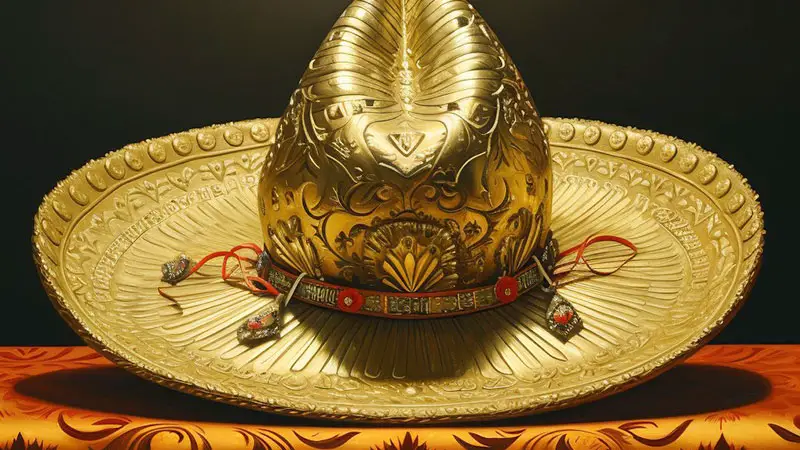In the world of baseball, striking out is a common occurrence, but there’s a special term for the rare and unfortunate feat of striking out four times in a single game: the golden sombrero.
Coined in the late 1970s, the phrase gained traction after a Baseball Digest writer dubbed Philadelphia Phillies player Greg Luzinski’s 0-for-4 game with four strikeouts as the “Golden Sombrero Award.”
Achieving a golden sombrero isn’t just about a batter’s performance; it also involves facing tough pitches and having enough at-bats. Each missed swing or weak contact with the ball inches a player closer to this unwanted title.
Understanding the origins and implications of the golden sombrero can help you appreciate the challenges batters face and the strategies they use to avoid this notorious mark.
The Golden Sombrero in Baseball
The “Golden Sombrero” is a term used in baseball to describe a player’s performance when they strike out four times in a single game. It’s an extension of the term “hat trick,” which originally refers to three strikeouts or hits in a game.
Origin and Meaning of the Term
The term “golden sombrero” in baseball originated in the late 1970s. A Baseball Digest writer coined the phrase while describing Philadelphia Phillies player Greg Luzinski, who struck out four times in a single game.
This rare feat led to the reference of a “Golden Sombrero Award.” The term quickly gained traction among writers and broadcasters, becoming a part of baseball lexicon.
It symbolizes the challenge and frustration faced by a player who experiences multiple strikeouts in one game.
How a Golden Sombrero Is Achieved
To achieve a golden sombrero, a player must strike out four times in one game.
Several factors contribute to this occurrence:
Multiple At-Bats
The player needs multiple opportunities in the game to accumulate four strikeouts. Achieving a golden sombrero is often seen as a negative milestone for hitters, highlighting a particularly tough game against the opposing pitchers.
Tough Pitchers
Facing skilled pitchers who can consistently throw challenging pitches increases the likelihood of striking out. Additionally, pressure situations and mental fatigue can contribute to a player’s struggles at the plate, sometimes leading to the dreaded golden sombrero.
Aggressive Hitting
A player attempting to hit home runs or make significant plays may strike out more often. Furthermore, the term “golden sombrero” refers to a player striking out four times in a single game. This phrase highlights the unpredictability and challenges faced by even the most skilled athletes.
Game Duration
Longer games with extra innings provide more chances for a player to reach the four-strikeout mark.
However, even during standard nine-inning games, the feat remains a notorious symbol of a tough day at the plate, often leading to valuable lessons for players and fans alike.
Impact of the Golden Sombrero
The “Golden Sombrero” in baseball, where a player strikes out four times in a single game, can have several impacts on the player and the team:
Effects on Player Performance and Morale
A golden sombrero significantly affects player performance and morale. Striking out four times in one game can mentally disrupt a player’s confidence.
This consecutive failure might embed self-doubt in even seasoned players, leading to mechanical changes in batting.
Players often overthink their strategies, resulting in altered swings or timing issues that affect subsequent games.
Examples of these impacts include Garry Templeton, who struck out three times against Nolan Ryan before finally hitting a home run.
Similarly, Larry Herndon struck out multiple times before succeeding in the 15th inning on July 22, 1980. These instances show how striking out multiple times can prolong a struggle before a positive result.
Reactions from Teams and Fans
The reactions from teams and fans to a golden sombrero can profoundly affect a player’s mindset. Teams may supportively bolster a struggling player by focusing on positive aspects.
For instance, San Diego skipper Larry Bowa showed exuberance when Garry Templeton eventually hit a home run after several strikeouts.
Fans’ reactions vary, ranging from frustration to unwavering support. Team loyalty often dictates whether fans rally behind a player or openly criticize them.
Emotional responses from fans and teammates can thus play a crucial role in either mitigating or exacerbating the player’s morale after a golden sombrero.
Notable Golden Sombrero Games in MLB History
In Major League Baseball (MLB) history, there have been several notable instances where players have earned the “Golden Sombrero” by striking out four times in a single game.
Here are a few memorable examples:
Players Famous for the Most Golden Sombreros
Several players have not only experienced a golden sombrero but also set records for the number of times they’ve struck out four times in a game.
Reggie Jackson, a Hall of Famer known for his prolific home-run hitting, has amassed 23 golden sombreros, one of the highest in MLB history. Ryan Howard, another power hitter, has recorded 27 such games throughout his career.
Mike Schmidt, despite his three MVP titles, had multiple games with four strikeouts, highlighting the unpredictable nature of the sport. This trend is often seen among players with a high strikeout rate but also tremendous hitting power.
Record-High Strikeout Games
Mike Schmidt’s game on May 28, 1983, stands out as one of the most remarkable golden sombrero moments. In this game, Schmidt struck out four times, facing 12 pitches, all strikes.
However, on his 13th pitch, he hit a two-run homer to secure a 5-3 victory for the Phillies over the Montreal Expos. Similarly, Larry Herndon’s performance on July 22, 1980, is notable.
After striking out four times, Herndon hit a decisive home run in the 15th inning, leading the Giants to a 2-0 win. These instances show how players can redeem themselves after facing multiple strikeouts in a single game.
| Player | Date | Strikeouts | Memorable Action |
|---|---|---|---|
| Mike Schmidt | May 28, 1983 | 4 | Hit a two-run homer on 13th pitch |
| Larry Herndon | July 22, 1980 | 4 | Homered in the 15th inning |
Strategies to Prevent Golden Sombreros
Preventing a Golden Sombrero (four strikeouts in a single game) requires a combination of technical preparation, mental focus, and strategic adjustments.
Here are several strategies that players and teams can employ:
Coaching Techniques to Reduce Strikeouts
Focus on pitch recognition drills to help players identify pitches quickly. Coaches often use colored balls or varying speeds during batting practice.
Emphasize the importance of a two-strike approach, encouraging contact over power. Batters can practice shortening their swing or widening their stance to increase their chances of making contact.
Utilize video analysis to identify flaws in a player’s swing mechanics. Reviewing game footage helps understand tendencies and make necessary adjustments.
Conduct regular plate discipline exercises focusing on patience. Simulated game situations where batters must focus on strike zone awareness improve decision-making under pressure.
Mental and Physical Preparation for Batters
Develop a pre-game routine to help players get into the right mental frame. Visualization exercises where players imagine successful at-bats can build confidence.
Encourage positive self-talk to counteract the pressure of potential strikeouts. Condition players to handle stress with breathing techniques or mindfulness exercises.
Strength training and conditioning programs are crucial to enhance bat speed and overall physical readiness. Monitor and adjust a player’s diet to ensure they have the necessary energy and focus during games.
Implement regular rest periods to prevent physical and mental fatigue, keeping players sharp throughout the season.
Frequently Asked Questions
Who coined the term golden sombrero?
The term “golden sombrero” is believed to have evolved from the “hat trick,” which denotes three strikeouts. The term adds an extra flair, denoting the more severe nature of four strikeouts.
How does a player typically react to a golden sombrero?
A golden sombrero can significantly impact a player’s morale and mental state. Players may experience frustration and pressure to perform better in subsequent games.
Are there famous examples of players overcoming a golden sombrero?
Yes, players like Garry Templeton and Larry Herndon have experienced golden sombreros but managed to turn their performance around in later games, illustrating resilience and skill.
How important is mental preparation in avoiding golden sombreros?
Mental preparation is crucial. Techniques like visualization, positive self-talk, and establishing a solid routine can significantly enhance a player’s mindset and performance.
Can physical conditioning help prevent golden sombreros?
Yes, physical conditioning, including proper diet, regular rest periods, and focused conditioning exercises, help maintain a player’s overall performance and reduce fatigue, potentially lowering the risk of a golden sombrero game.
Conclusion
Understanding the golden sombrero gives you a deeper appreciation of the challenges baseball players face. While striking out four times in a game can be disheartening, it’s also an opportunity for growth and improvement.
By focusing on strategies like pitch recognition drills and maintaining a strong mental and physical routine, players can enhance their skills and resilience.
Remember, even the most successful athletes have faced setbacks, and it’s their perseverance that sets them apart. So the next time you witness a golden sombrero, you’ll know it’s just a stepping stone on the path to greatness.
By learning from each experience and analyzing their performance, players can turn these moments into valuable lessons.
Coaches and fans alike should support players through such challenges, fostering an environment of continuous development.
Recognizing the effort and dedication required to compete at a high level will deepen your appreciation of the sport.








Pat Bloom